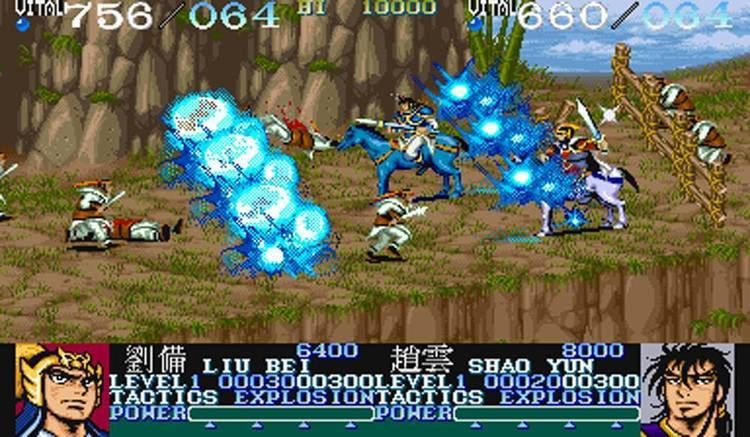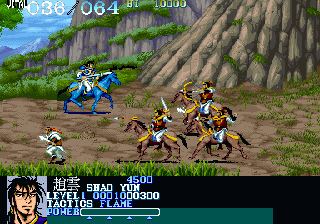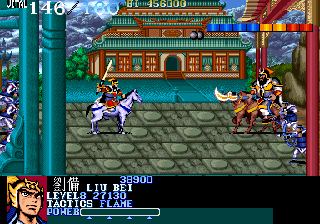9.2 /10 1 Votes
Arcade system CPS-1 | 4.6/5 CoolROM Cabinet Upright Initial release date 1989 | |||||||||||||||||||||||||||||||||
 | ||||||||||||||||||||||||||||||||||
Release date(s) April 1989 (Japan)July 1989 (World) Mode(s) multi-player; up to 2 players simultaneously Display Raster 384 x 224 pixels (Horizontal), 4096 colors Platforms Similar Warriors of Fate, Destiny of an Emperor, Tenchi wo Kurau II, The King of Dragons, Cadillacs and Dinosaurs | ||||||||||||||||||||||||||||||||||
Arcade longplay 335 dynasty wars
Dynasty Wars, released in Japan as Tenchi o Kurau (Japanese: 天地を喰らう, Hepburn: lit. The Devouring of Heaven and Earth), is a side-scrolling beat-'em-up arcade game released in 1989 by Capcom, based on a Japanese manga Tenchi wo Kurau and a reenactment of the battle between the Kingdom of Shu and the Yellow Turban rebels. Each of the two players can assume the roles of one of the four Chinese generals riding on horseback from the Three Kingdoms period in an attempt to smash the rebellion.
Contents
- Arcade longplay 335 dynasty wars
- 1989 dynasty wars arcade game playthrough retro game
- Gameplay
- Conversions
- Production staff
- Trivia
- References

1989 dynasty wars arcade game playthrough retro game
Gameplay

The players' goal is to wipe out the Huang Ching, the organization responsible for the unrest of the Han Dynasty and later defeat the tyrant Dong Zhuo, and up to two players can fight side by side to accomplish this goal. This game always scrolls to the right. Players must be able to survive the rebel hordes to reach and kill the rebel general in each stage to free the province.

Players can use three buttons: to attack left, attack right, or use special tactics. In the arcade version, inserting more coins and pressing START increases the maximum life of the player. In an RPG style, completing stages and collecting yellow orbs increase the experience points of the player in order to level-up, where he gains more vitality and use stronger weapons. These weapons are upgraded for every 3rd blue orb collected. In-game treasure increases player score, and food packs replenish vitality.
There are 4 selectable characters, each with their own varying amounts of attack power and initial vitality. Aside from unique weaponry, each character also has a unique partner character during a certain special attack. For every 3 blue orbs collected, the player's weapon improves, depending on his current level range.
There are a total of eight stages (called rounds), corresponding a province in reference to the historic battles in the novel.
Conversions
Home computer versions for the ZX Spectrum, Amstrad CPC and Commodore 64 were developed by Tiertex and published by U.S. Gold in 1990. The ZX Spectrum version was received with mixed reviews; Your Sinclair awarded 80%, highlighting the detailed graphics and horse-mounted theme of combat, but CRASH rated it only 44%, criticizing the monochrome graphics, juddering scrolling and dull gameplay.
NEC Avenue produced a PC Engine version of Tenchi o Kurau, which was released exclusively in Japan in 1994. The PC Engine version was released in Super CD-ROM² format, and is a faithful conversion, although suffers from smaller sprites and pauses during play. As it is CD based, it benefits from an extensive intro and in-game cut scenes.
Production staff
Trivia
Pony Canyon / Scitron released a limited-edition soundtrack album for this game (Strider Hiryu : G.S.M. Capcom 2 - D25B1001) on 21/05/1989.
The man at the game's epilogue is Cao Cao (Akkhila-Orkhan). The Dynasty Wars 2 mentioned at the end of the game is actually the 3-player beat-'em-up Warriors of Fate. Though supposedly killed, Li Pu (Lu Bu aka Temujin-Khan) is Cao Cao's righthand and you have to kill him before the final battle with the evil warlord Cao Cao.
